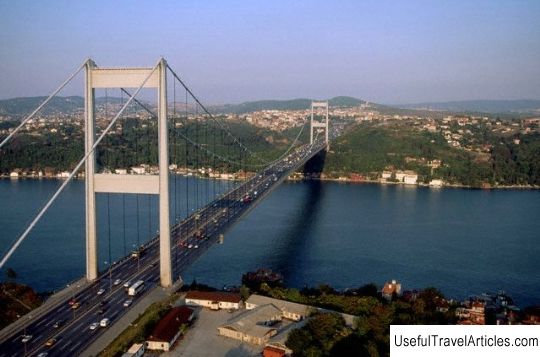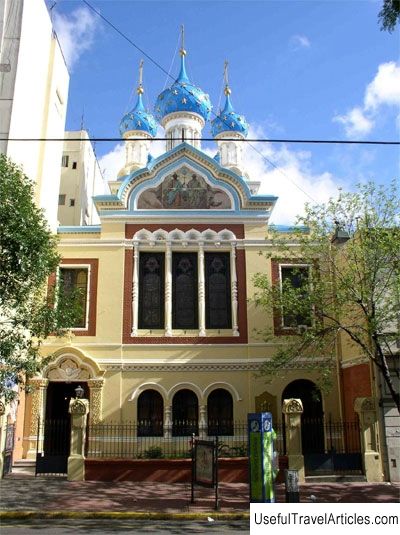Second Bosphorus Bridge or Sultan Mehmed Fatih Bridge (Fatih Sultan Mehmet Koprusu) description and photos - Turkey: Istanbul
Rating: 7,9/10 (1289 votes) 
Second Bosphorus Bridge or Sultan Mehmet Fatih Bridge (Fatih Sultan Mehmet Koprusu) description and photos - Turkey: Istanbul. Detailed information about the attraction. Description, photographs and a map showing the nearest significant objects. The name in English is Fatih Sultan Mehmet Koprusu. Photo and DescriptionThe Second Bosphorus Bridge or Sultan Mehmed Fatih Bridge is the second suspension bridge across the Bosphorus. The bridge connects the Rumeli Hisary district in the European part and Anadolu Hisary in the Asian part of Istanbul. It was built next to the fortresses of Rumeli Hisary and Anadolukhisary, which in 1985-1988. controlled the Bosphorus. The bridge is named after the Sultan of the Ottoman Empire Mehmed Fatih the Conqueror, who discovered Constantinople in 1453. It was designed by Freeman Fox & Partners, the international consortium that previously developed the Bosphorus Bridge. The structure is located behind the 15th century defensive fortress of Rumeli Hisary, closer to the Black Sea, crosses the Bosphorus Strait and is located 5 kilometers north of the First Bosphorus Bridge. Construction of the Sultan Mehmed Fatih Bridge began in 1985 and was completed in 1988. Its opening, which took place on May 29, 1988, also marked one of the jubilee and memorable dates in Turkish history - this is 535 years since the conquest of Constantinople by Sultan Mehmed Fatih. It is also known that the Second Bosphorus Bridge was erected on the same place where the first pontoon bridge of King Darius was located almost two and a half thousand years earlier. This bridge, despite the fact that it was built by Japanese builders according to the same structural scheme as and the First Bosphorus Bridge, which is a suspended web and a system of guy wires between the pylons on cables, using the same material (steel), is a more powerful structure, which surpasses its predecessor (both in the length of the central span and in the amount of costs for its construction). The length of the bridge itself is about 1510 meters. The length of the main span is 1090 meters, the width is 39 meters, and the height of the supports is 165 meters above the water level. The distance from the roadway to the water surface is 64 meters. The bridge became famous as one of the largest bridges and is the twelfth longest in the world. About 130 million US dollars were spent on its construction. For the construction of the Sultan Mehmed Fatih bridge, the engineers who designed it did not invent new constructive solutions and materials, but used the cable-stayed steel bridge system, which has long been used in America and Europe. Pylons of bridges, sharply soaring above the water and echoing the towers of minarets, mosques located on the banks of the Bosphorus, and modern radio and television towers, give its steel parts a completely new sound. Therefore, we can safely say that not only the transport function of bridges across the Bosphorus, but also a well-chosen shape, connect the East with the West, Europe and Asia. The main supporting structure of the bridge was made of flexible cables, chains and ropes, which work in tension, while the roadway remains suspended. During its construction, ropes and wire cables were used, consisting of high-strength steel, the tensile strength of which is from 2 to 2.5 Gn / m2 (200-250 kgf / mm2). This significantly reduces the dead weight of the bridge and allows large spans to be covered. Along with this, it has low rigidity because that due to the movement of the temporary load on the bridge, the cable or chain changes its geometric shape and causes large deflections of the span. In order to reduce deflections, the bridge was reinforced with longitudinal beams and rigidity trusses along the level of its carriageway. This helped to distribute the live load and reduce cable deformation. The Second Bosphorus Bridge is not a pedestrian bridge. It is a high-speed transport highway, which is charged for travel. Every day about one hundred and fifty thousand units of transport pass through it, which carry more than five hundred thousand passengers. The pedestrian walkway across the bridge was closed due to the fact that it was used many times to commit suicide.      We also recommend reading Church of the Nativity of John the Baptist on Kamenny Island description and photos - Russia - Saint Petersburg: Saint Petersburg Topic: Second Bosphorus Bridge or Sultan Mehmed Fatih Bridge (Fatih Sultan Mehmet Koprusu) description and photos - Turkey: Istanbul. |




